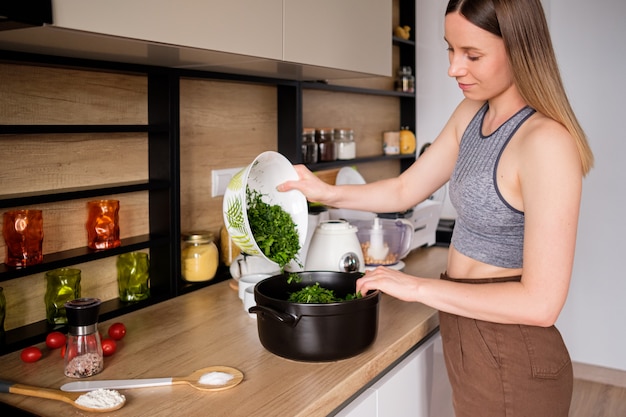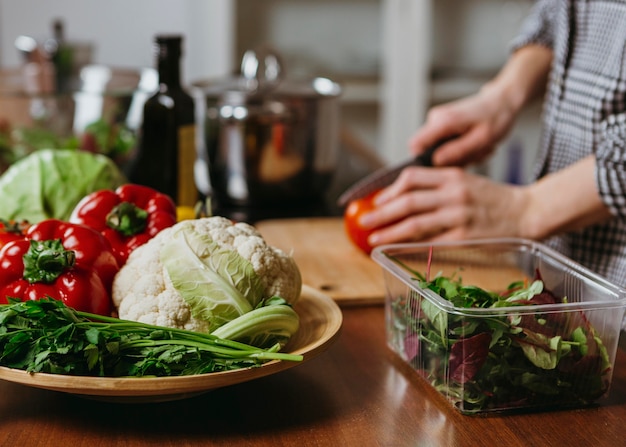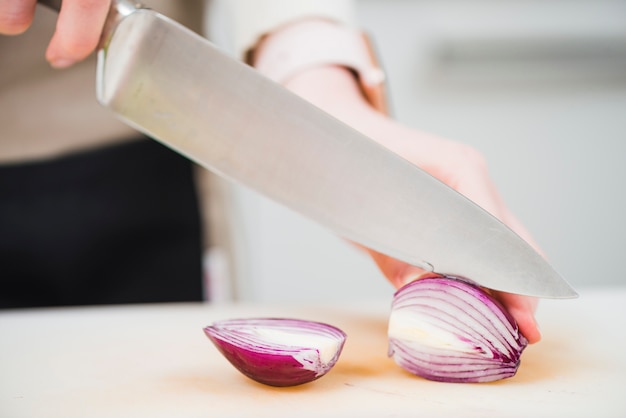Cabbage. It's a staple in many kitchens, often relegated to the back of the fridge, but its versatility is truly remarkable. From simple stir-fries to hearty stews, cabbage can be the star of the show, and it's surprisingly easy to master. Over the years, I've discovered endless ways to cook cabbage, and I'm here to share my insights and passion for this humble vegetable.
(Part 1) Choosing Your Cabbage: A Head Start to Flavor

First things first, we need to pick the right cabbage. While green cabbage is a classic choice, don't overlook the vibrant colour and slightly sweeter flavour of red cabbage. For a unique twist, try savoy cabbage – its crinkly leaves and delicate taste will surprise you.
The Cabbage Check-Up: Picking the Perfect Head
Before you start chopping, give your cabbage a good look-over. You want a firm head with tightly packed leaves, free from any soft spots or discolouration. If you're looking for a sweeter flavour, try using the cabbage heart – it's the core of the cabbage and packs a punch of sweetness.
Cutting Cabbage: Mastering the Art of Precision
Now, let's prep that cabbage! The key to a good cabbage dish is consistent cutting. Whether you're slicing, dicing, or shredding, aim for even pieces that will cook evenly.
Slicing: Perfect for braising or stir-frying, slicing allows the cabbage to cook evenly while retaining some of its structure. Use a sharp chef's knife or a mandoline for precise cuts.
Dicing: For a more substantial bite, dice your cabbage into small cubes. This works great in soups, stews, or salads where you want a more pronounced cabbage flavour.
Shredding: Shredded cabbage is ideal for coleslaw, salads, or stir-fries. A sharp knife or a mandoline will do the trick, but a good quality grater will make quick work of it.
(Part 2) Stovetop Techniques: A Guide to Deliciousness

Now that you've got your cabbage prepped, let's dive into the exciting world of stovetop techniques!
1. Braising: The Gentle Art of slow cooking
Braising is a classic method for cooking cabbage that brings out its natural sweetness and tenderness. It's a slow, gentle process that allows the flavours to meld beautifully.
How to Braise: Start by browning some diced bacon or pancetta in a large, heavy-bottomed pot. Then, add sliced cabbage, onions, garlic, and your favourite aromatics like thyme or bay leaf. Pour in some stock, wine, or broth, cover the pot, and let it simmer for about 45 minutes, or until the cabbage is meltingly soft.
Tips: For a richer flavour, add a bay leaf, thyme, or a sprig of rosemary to the pot. You can also deglaze the pan after browning the bacon with a little wine or broth to add extra depth of flavour.
Variations: braised cabbage is a delicious side dish for roasted meats or hearty stews. You can add a sprinkle of caraway seeds for a classic twist, or try a splash of vinegar for a tangy kick.
2. Stir-Frying: Speed, Heat, and Flavor
Stir-frying is a quick and easy way to cook cabbage, perfect for a mid-week meal. It's all about speed and heat, resulting in a deliciously crisp and flavourful dish.
How to Stir-fry: Heat a wok or a large frying pan over high heat. Add some oil and your favourite stir-fry ingredients, such as sliced cabbage, carrots, garlic, ginger, and soy sauce. Stir-fry for 3-4 minutes, or until the cabbage is just tender-crisp.
Tips: Make sure your wok is really hot before adding the oil. Don't overcrowd the pan; work in batches if necessary. Use a high-heat cooking oil, like peanut oil or sesame oil.
Variations: stir-fried cabbage is a delicious base for many dishes. Try adding some shrimp, chicken, or tofu for a complete meal. Experiment with different sauces, from classic soy sauce to a spicy chili garlic sauce.
3. Sautéing: Simplicity Meets Flavor
Sautéing is a simple technique that delivers tender and flavorful cabbage in just a few minutes.
How to Sauté: Heat some oil in a frying pan over medium heat. Add sliced cabbage and your preferred ingredients, such as onions, garlic, or spices. Sauté for about 5 minutes, or until the cabbage is tender-crisp.
Tips: Don't overcook the cabbage; you want it to remain slightly crisp. Season with salt, pepper, and a squeeze of lemon juice for a bright and tangy finish.
Variations: Sautéed cabbage is perfect as a side dish or as part of a larger dish. It's also delicious with a splash of vinegar, a sprinkle of paprika, or a handful of fresh herbs.
(Part 3) Cabbage Crunch: A Balancing Act

One of the challenges with cooking cabbage is getting the texture right. You don't want it to be mushy or overly crisp. Here are some tips to help you nail that perfect cabbage crunch:
Avoid Overcrowding the Pan: If you overcrowd the pan, the cabbage will steam instead of sautéing or stir-frying, resulting in a mushy texture. Work in batches if necessary.
Don't Overcook: The key is to cook the cabbage just until it's tender-crisp. It will continue to cook even after you remove it from the heat, so be sure to take it off the heat a minute or two before it reaches your desired doneness.
Use the Right Amount of Liquid: When braising cabbage, the amount of liquid you use will affect the texture. Too much liquid will make the cabbage soggy, while too little liquid will make it tough. Use just enough to cover the cabbage.
(Part 4) Adding Flavor: The Magic Touch
The beauty of cooking cabbage is that you can easily customize it to your taste. Here are some of my favourite flavour combinations:
Spicy: Add some chili flakes, jalapeno peppers, or sriracha sauce for a kick.
Savoury: Use smoked paprika, bacon, or sausages for a smoky flavour.
Sweet: Add a touch of sweetness with a drizzle of honey, maple syrup, or brown sugar.
Herby: Fresh herbs like parsley, dill, thyme, and rosemary can elevate the flavour of any cabbage dish.
(Part 5) Cabbage in Dishes: From Classics to Creations
Cabbage is a versatile ingredient that shines in many dishes. Let's explore a few favourites:
1. cabbage rolls: comfort food with a Twist
Cabbage rolls are a classic dish that's both comforting and delicious. They consist of ground meat, rice, and vegetables wrapped in cabbage leaves and simmered in a flavorful broth.
Tips: Blanch the cabbage leaves for a few minutes to make them more pliable. Use a mixture of ground beef, pork, and veal for the best flavour.
Variations: Cabbage rolls can be filled with all sorts of things, from mushrooms and lentils to vegetarian fillings like quinoa and chickpeas.
2. Coleslaw: Crunchy and Refreshing
Coleslaw is a classic side dish that's refreshing and flavourful. It's made with shredded cabbage, usually mixed with mayonnaise, vinegar, and other seasonings.
Tips: Use a mandoline to shred your cabbage for a uniform texture. For a tangy flavour, use a combination of mayonnaise and vinegar.
Variations: Coleslaw can be dressed up with a variety of different ingredients, such as carrots, apples, cranberries, or even nuts. Experiment with different dressings, from classic mayonnaise-based to creamy yogurt-based.
3. Cabbage Soup: Hearty and Healthy
Cabbage soup is a hearty and healthy option, perfect for a cold winter day. It's made with cabbage, broth, and other vegetables, and can be customized with different seasonings and toppings.
Tips: Use a combination of different vegetables, such as carrots, potatoes, celery, and onions, for a well-rounded flavour. Add a pinch of cumin or coriander for an extra depth of flavour.
Variations: Cabbage soup can be made with different types of broth, including vegetable broth, chicken broth, or beef broth. You can add lentils or beans for extra protein and texture.
(Part 6) Sauerkraut: The Fermented Delight
Sauerkraut is a fermented cabbage dish that's both tangy and delicious. It's made by fermenting shredded cabbage with salt, and it's a staple in many cuisines.
Making Sauerkraut: You can make your own sauerkraut at home, but it requires a bit of patience and attention to detail. Shred your cabbage, add salt, and pack it tightly into a jar or crock. Let it ferment for several weeks in a cool, dark place.
Tips: Use a good quality salt for the best results. Make sure the cabbage is packed tightly to prevent air pockets.
Using Sauerkraut: Sauerkraut is delicious on its own, but it's also a great addition to many dishes, such as sausages, pork chops, or even sandwiches.
(Part 7) The Cabbage Chronicles: A Personal Journey
My love affair with cabbage began with my grandmother's classic braised cabbage. She used to cook it with bacon, onions, and a touch of caraway seeds, and it was pure magic. The sweetness of the cabbage, the smokiness of the bacon, and the warmth of the caraway seeds – it was a perfect blend of flavours.
Since then, I've explored countless other ways to cook cabbage. I've made stir-fries with ginger and garlic, coleslaw with a creamy honey mustard dressing, and even cabbage soup with a spicy kick.
Cabbage has taught me the value of simplicity and the power of flavour. It's a humble vegetable that can be transformed into something truly extraordinary with just a little bit of creativity.
(Part 8) FAQs: Your Cabbage Questions Answered
Let's address some common questions about cooking cabbage.
1. What are some healthy ways to cook cabbage?
Cabbage is packed with nutrients and antioxidants, making it a great choice for a healthy diet. Here are some tips for cooking it in a healthy way:
Steam or Sauté: These methods require little to no oil, making them healthier than frying.
Choose Lean Protein: When making cabbage rolls, opt for lean ground turkey or chicken instead of ground beef.
Use Broth or Water: Instead of heavy cream, use broth or water to cook your cabbage soup.
2. How long does it take to cook cabbage?
The cooking time for cabbage will vary depending on the method you choose.
Braising: 45 minutes to 1 hour
Stir-frying: 3-5 minutes
Sautéing: 5-7 minutes
Boiling: 10-15 minutes
3. How can I tell when cabbage is cooked?
The best way to know when cabbage is cooked is to check for its tenderness. It should be soft but still retain its structure. The leaves should be easily pierced with a fork.
4. How do I store cabbage?
Store your cabbage in the refrigerator for up to a week. Keep it wrapped in plastic wrap or a reusable bag to prevent it from drying out.
5. What happens if I overcook cabbage?
Overcooked cabbage will become mushy and lose its flavour. It's best to cook it until it's tender-crisp, but not overcooked.
(Part 9) Embrace the Humble Cabbage: A culinary adventure Awaits
So, there you have it! A complete guide to cooking cabbage like a pro. Don't be afraid to experiment and find what flavours you love. Cabbage is a blank canvas, ready for your culinary creativity. Happy cooking!
Everyone is watching

How to Cook Frozen Lobster Tails Perfectly: A Step-by-Step Guide
RecipesLobster. Just the word conjures up images of lavish meals, special occasions, and a taste of luxury. But let's...

Pigs in a Blanket Cooking Time: How Long to Bake for Perfect Results
RecipesAh, pigs in a blanket. Just the name conjures up images of those delightful little parcels of crispy pastry en...

Pork Fillet Cooking Time: How Long to Cook It Perfectly
RecipesPork fillet, or tenderloin as it's sometimes called, is a real favourite in our house. It's so versatile, and...

The Ultimate Guide to Cooking Delicious Frankfurters
RecipesLet's face it, we all love a good frankfurter. It's a classic, simple, and always satisfying. But let's be rea...

Wolf Meat Recipes: A Guide to Cooking Wild Game
RecipesLet's be honest, you don't see wolf meat at your local butcher shop every day. It's a bit of a wild card, but ...
